当前位置:
X-MOL 学术
›
Acta Mater.
›
论文详情
Our official English website, www.x-mol.net, welcomes your feedback! (Note: you will need to create a separate account there.)
Nano-scale corrosion mechanism of T91 steel in static lead-bismuth eutectic: A combined APT, EBSD, and STEM investigation
Acta Materialia ( IF 9.4 ) Pub Date : 2024-04-02 , DOI: 10.1016/j.actamat.2024.119883 Minyi Zhang , Guanze He , Mark Lapington , Weiyue Zhou , Michael P. Short , Paul A.J. Bagot , Felix Hofmann , Michael P. Moody
Acta Materialia ( IF 9.4 ) Pub Date : 2024-04-02 , DOI: 10.1016/j.actamat.2024.119883 Minyi Zhang , Guanze He , Mark Lapington , Weiyue Zhou , Michael P. Short , Paul A.J. Bagot , Felix Hofmann , Michael P. Moody

|
T91 steel is a candidate material for structural components in lead-bismuth-eutectic (LBE) cooled systems, for example fast reactors and solar power plants . However, the corrosion mechanisms of T91 in LBE remain poorly understood. In this study, we have analysed the static corrosion of T91 in liquid LBE using a range of characterisation techniques at increasingly smaller scales. A unique pattern of liquid metal intrusion was observed that does not appear to correlate with the grain boundary network. Upon closer inspection, electron backscatter diffraction (EBSD) reveals a change in the morphology of grains at the LBE-exposed surface, suggesting a local phase transition. Energy dispersive X-ray (EDX) maps show that Cr is depleted in the T91 material near the LBE interface. Furthermore, we observed the dissolution of all Cr-enriched precipitates in this region. Although the corrosion is conducted in an oxygen deficient environment, both scanning transmission electron microscopy (STEM) and atom probe tomography (APT) reveal a thin surface oxide layer (presumably wüstite) at the LBE-steel interface. Using electron energy loss spectroscopy (EELS) in the STEM, as well as APT, the atomic scale elemental redistribution and 3D morphology of the corrosion interface is investigated. By combining results from these different techniques, several types of oxide phases and structures can be identified. Based on this detailed nano-scale information, we propose potential mechanisms of T91 corrosion in LBE.
中文翻译:

T91 钢在静态铅铋共晶中的纳米级腐蚀机制:APT、EBSD 和 STEM 联合研究
T91 钢是铅铋共晶 (LBE) 冷却系统结构部件的候选材料,例如快堆和太阳能发电厂。然而,T91 在 LBE 中的腐蚀机制仍然知之甚少。在这项研究中,我们使用一系列表征技术在越来越小的尺度上分析了 T91 在液体 LBE 中的静态腐蚀。观察到液态金属侵入的独特模式,该模式似乎与晶界网络无关。经过仔细观察,电子背散射衍射 (EBSD) 揭示了 LBE 暴露表面晶粒形态的变化,表明存在局部相变。能量色散 X 射线 (EDX) 图显示 LBE 界面附近的 T91 材料中 Cr 被耗尽。此外,我们观察到该区域所有富铬沉淀物的溶解。尽管腐蚀是在缺氧环境中进行的,但扫描透射电子显微镜 (STEM) 和原子探针断层扫描 (APT) 均显示 LBE-钢界面处存在薄薄的表面氧化层(推测为方铁矿)。使用 STEM 中的电子能量损失谱 (EELS) 以及 APT,研究了腐蚀界面的原子级元素重新分布和 3D 形貌。通过结合这些不同技术的结果,可以识别几种类型的氧化物相和结构。基于这些详细的纳米级信息,我们提出了 LBE 中 T91 腐蚀的潜在机制。
更新日期:2024-04-02
中文翻译:

T91 钢在静态铅铋共晶中的纳米级腐蚀机制:APT、EBSD 和 STEM 联合研究
T91 钢是铅铋共晶 (LBE) 冷却系统结构部件的候选材料,例如快堆和太阳能发电厂。然而,T91 在 LBE 中的腐蚀机制仍然知之甚少。在这项研究中,我们使用一系列表征技术在越来越小的尺度上分析了 T91 在液体 LBE 中的静态腐蚀。观察到液态金属侵入的独特模式,该模式似乎与晶界网络无关。经过仔细观察,电子背散射衍射 (EBSD) 揭示了 LBE 暴露表面晶粒形态的变化,表明存在局部相变。能量色散 X 射线 (EDX) 图显示 LBE 界面附近的 T91 材料中 Cr 被耗尽。此外,我们观察到该区域所有富铬沉淀物的溶解。尽管腐蚀是在缺氧环境中进行的,但扫描透射电子显微镜 (STEM) 和原子探针断层扫描 (APT) 均显示 LBE-钢界面处存在薄薄的表面氧化层(推测为方铁矿)。使用 STEM 中的电子能量损失谱 (EELS) 以及 APT,研究了腐蚀界面的原子级元素重新分布和 3D 形貌。通过结合这些不同技术的结果,可以识别几种类型的氧化物相和结构。基于这些详细的纳米级信息,我们提出了 LBE 中 T91 腐蚀的潜在机制。



























 京公网安备 11010802027423号
京公网安备 11010802027423号